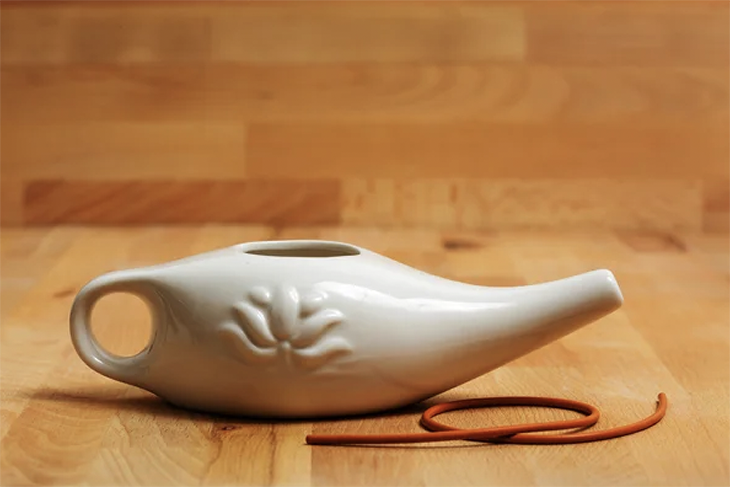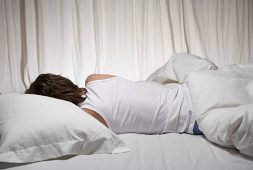
If you’ve never used a neti pot, then this photo may confuse you just a little. A neti pot happens to be a pot that looks very much like Aladdin’s lamp, which was first made and used around 500 years ago to help cleanse the nose of blockages using a water and salt solution.
Over the years, the neti pot has gained both popularity and acceptance, alongside many other machines that help people dealing with sinus, allergy, and breathing issues. However, people have also started using water straight from the tap for either neti pots, vaporizers, CPAP (continuous positive airway pressure) machines for sleep apnea, and humidifiers, but what they may not realize is that they are opening themselves up for serious – even potentially life-threatening – infections and disease. This comes from the findings of a survey from Center for Disease Control and Prevention (CDC) that were published in their February 2023 Emerging Infectious Diseases issue.
According to the survey authors, when people use unsterilized tap water in such equipment, like the neti pot, it can be risky due to the low levels of microorganisms that tend to remain in the drinking water distribution systems and wells. Such microorganisms include biofilm pathogens, which happens to be a kind of germ that sticks to water pipes and penetrate the water system, hence infecting the water that passes through the pipes.
Some of these potential pathogens that can be found in tap water are Pseudomonas aeruginosa, nontuberculous mycobacteria (NTM), Legionella spp., and Naegleria fowleri. The report also states that more often than not, ‘these are the germs that are responsible for a large portion of the 120,000 hospitalizations, 7,000 deaths, and billions in direct healthcare costs annually related to waterborne diseases.’
Report Shares Lack of Information About Tap Water and Home-Use Medical Devices
Back in August 2021, the researchers from the CDC did a survey of 1,004 people throughout the United States to try and figure out what their awareness levels were like when it comes to the risks of using tap water in medical devices such as CPAP machines and neti pots.
What they found was that around 1in 3 people that were surveyed had incorrect answers about tap water not containing bacteria or other living organisms.
The report also shared these additional findings form the survey, as stated below:
- Sixty-two percent of participants said (incorrectly) that tap water can be used for nasal rinsing.
- Fifty percent believed it was safe to rinse contact lenses with tap water, another no-no.
- Forty-two percent thought tap water was safe for use in respiratory devices such as vaporizers (often used to treat asthma, allergies, and bronchitis), humidifiers, or CPAP machines, which is also incorrect.
Moreover, the study authors also share that these findings suggest that most people aren’t necessarily aware of using nonsterile tap water for any home medical device, which then places them at an increased risk of getting unwanted infections.
In addition, those with weakened immune systems, such as the elderly or young children – especially infants – are at a higher risk of acquiring serious health complications, even death, from particular waterborne diseases.
Professor of medicine in the division of allergy and infectious diseases at the University of Washington School of Medicine in Seattle, Paul Pottinger, MD, said, “This is an important topic, and this report does a good job of raising people’s awareness of the importance of using sterilized water anytime they are washing out their airways or sinuses, and anytime they are adding water to their CPAP machine.” Notably, Dr. Pottinger wasn’t part of the study.
So Why Can We Drink Tap Water But Not Use it For Home-Use Medical Devices?
According to Dr. Pottinger, generally, the body is able to cope with commonplace germs in tap water. He explains, “Our intestinal system has a wonderful immune system that allows it to cope with microorganisms that may be contained in the water.”
However, he also says that anyone that has ever gotten acute gastroenteritis – otherwise known as a stomach virus – especially when traveling abroad knows that there is some tap water that isn’t considered potable.
He adds, “Thankfully, here in the United States, we usually have access to water that is considered clean enough to be drinkable. This is usually called ‘potable water.”
Dr. Pottinger also explains that most people usually have more issues when potable water with unsafe germs comes into contact with the lungs or nasal passages, since the immune function in those areas is quite different than that of the intestinal system. He also says, “Unfortunately, we have lost patients to fatal infections.”
There Has Been A Fatality In A Rare Case of Neti Pot Use and Unsterilized Tap Water
According to a 2018 report published in the International Journal of Infectious Diseases (PDF), in a rare case, one death was caused after a 69-year old Seattle woman used a neti pot to rinse her sinuses with unsterilized tap water after she contracted Balamuthia mandrillaris.
Meanwhile, according to another report on CBS , the Naegleria fowleri bacteria, which is also commonly called the “brain-eating amoeba,” managed to cause two deaths in neti pot users back in 2011.
Also according to the CDC, the Acanthamoeba keratitis, which is a serious eye infection, can also cause blindness or other types of permanent eye damage. They also share that around 85 percent of people in the United States get this infection from using contact lenses, who may have also chosen to clean their lenses using unsterilized tap water or otherwise contaminated or formerly sued contact lens solution.
Ways to Properly Treat Water Before Using It In Neti Pots and CPAP Machines
Dr. Pottinger explains, “The easiest way to sterilize water and make it suitable for use in a neti pot or CPAP machine is to bring it to a rolling boil for one minute and then allow it to cool to room temperature.” He adds that the water will remain sterile until it’s used, for as long as you keep it covered and in a clean area.
The CDC also shares that you can buy distilled or sterile water, but you still need to make sure that it clearly states that designation on the label.
“Sterilized water is water that has been treated, either by filtration or heat or chemicals, to kill any microbes that it contains. It poses no risk for infection even when administered into the sinus pathway,” Dr. Pottinger adds. But he also says that people should keep in the mind that not all water must be sterile before it can be safe to drink. But if you are traveling to particular countries, sterile may be the best choice.



